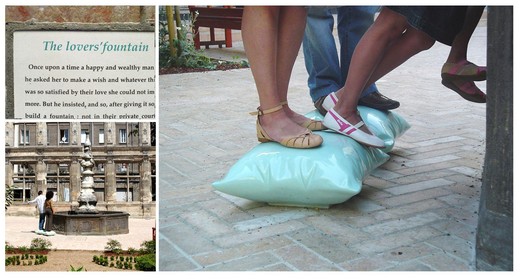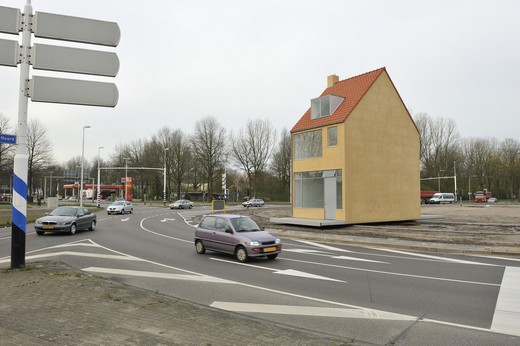22 May 2008
Tour of Cliftonville
Featuring: Doloras, Finbar, Dan, Mairead and Steven.
Directed and editted by Michelle Nolan
Play Hut Location
Dan and Steven expressing their needs and wants for a play hut. We decided on a location and the lads were consulted regularly on the design of the play hut.
20 May 2008
Vito Acconci
Vito Acconci and Steven Holl, put up a long fibro-clad wall to the street enclosing the space. This wall has a series of variously shaped cutouts that spin along their horizontal and vertical axis. In the closed position, they form a wall to the street, and completely enclose the gallery space, and in the open position they open out onto the street, effectively doubling the gallery space by inhabiting the street. This is Storefront for Art and Architecture, New York City.










Vito Acconci
"Model for a Playground", 1983
Mixed media, 102 x 52 x 5.3 cm
Cécile PITOIS, Sculptures for the public space
Cécile PITOIS, Sculptures for the public space | |
 | |
For several years, Cécile Pitois has been developing Wishing Sculptures projects (Sculptures à souhaits), which are intended for urban settings: combining sculptures and texts, this works enables the imaginary to crystallize itself around legends invented by the artist like so many fragments of an upcoming mythology.
For each of her creations, Cécile Pitois invites the audience to share a ritual inspired by the site?s historical, social and cultural context. This ritual dimension implies a double experience -- at once intimate and collective -- of the moment and place. Medium of a social link between the users of this shared space which is the city, Cécile Pitois? work casts an at once critical and poetic gaze on our urban environment.
In 2005, Cécile Pitois conceived A mon seul désir (To My Only Desire) for the Rivau Castle in Lemeré, France. A commission created with the help of the Fondation de France?s Nouveaux Commanditaires program; of the Association des Amis du Château du Rivau; of the Conseil Régional du Centre and of the Fondation d?entreprise Bernardaud. Produced by Eternal Network.
In 2006, she created La Fontaine des amoureux (The Lover?s Fountain) for the Beaune-Semblançay plaza in Tours (France). Commissioned by the city of Tours with the help of the Drac Centre. Produced by Eternal Network.
She is currently undertaking a research project in New York based on her exploration of this city which embodies in an extreme manner the notion of the individual?s dispersion amidst collective rhythms and space. She will exhibit several pieces including A Piece of the Puzzle for Governor?s Island; Whistling Benches for Central Park, as well as Me, Me, Me and You for Sunset Park, a work which deals with the issue of multiculturalism, amongst other.
For each of her creations, Cécile Pitois invites the audience to share a ritual inspired by the site?s historical, social and cultural context. This ritual dimension implies a double experience -- at once intimate and collective -- of the moment and place. Medium of a social link between the users of this shared space which is the city, Cécile Pitois? work casts an at once critical and poetic gaze on our urban environment.
In 2005, Cécile Pitois conceived A mon seul désir (To My Only Desire) for the Rivau Castle in Lemeré, France. A commission created with the help of the Fondation de France?s Nouveaux Commanditaires program; of the Association des Amis du Château du Rivau; of the Conseil Régional du Centre and of the Fondation d?entreprise Bernardaud. Produced by Eternal Network.
In 2006, she created La Fontaine des amoureux (The Lover?s Fountain) for the Beaune-Semblançay plaza in Tours (France). Commissioned by the city of Tours with the help of the Drac Centre. Produced by Eternal Network.
She is currently undertaking a research project in New York based on her exploration of this city which embodies in an extreme manner the notion of the individual?s dispersion amidst collective rhythms and space. She will exhibit several pieces including A Piece of the Puzzle for Governor?s Island; Whistling Benches for Central Park, as well as Me, Me, Me and You for Sunset Park, a work which deals with the issue of multiculturalism, amongst other.
John Korneling, The Rotating House
John KÖRMELING, The Rotating House (2008). Tilburg (The Netherlands) |
 |
| The Rotating House of Körmeling is a permanent public art work, located on the Hasselt roundabout, at one of the main entrance to the city of Tilburg. A detached house with a front and back garden is located on the Hasselt roundabout. The house, which looks real, is rotating on the roundabout in the direction of the traffic and completes one full circle in 20 hours. The house is a full-scale model (5 meters wide, 8.5 meters deep and 10 meters high). It is not fit for human habitation; it consists of a steel construction covered with red brick strips and tiles. The windows are made of laminated glass with white window frames. The front and back gardens are made up of artificial turf. At night the house is illuminated from the inside. The house is closed but, with a key, you can enter the house through the front door for potential maintenance. Grass grows on the roundabout itself. The distance between the garden and the road amounts to a meter. The house has 4 track wheels placed on rails. The mechanism is driven by four wheels with 24 Volt deriving from a solar panel. Another mechanism ensures that the house automatically stops as soon as something bumps into it. In explaining his design John Körmeling states that he wants to provide drivers waiting at the roundabout with a feeling of alienation from reality by having the house rotate. Normally the driver is moving while the construction stands still. The alienation effect will, however, not be immediately perceivable. After all, the house only rotates very slowly (once all the way around in 20 hours). If you return at a later time you will experience this ?disconnection? from reality because the house has moved. Moreover, the work offers a commentary on the construction of the Hasselt roundabout itself which created a gap in the integrity of the historic belt of Tilburg in the sixties and separated Hasselt Street from the Chapel of Hasselt, a much frequented chapel to the virgin Mary and an important cultural-historical site . |
| Car as flower Box |
Subscribe to:
Comments (Atom)



